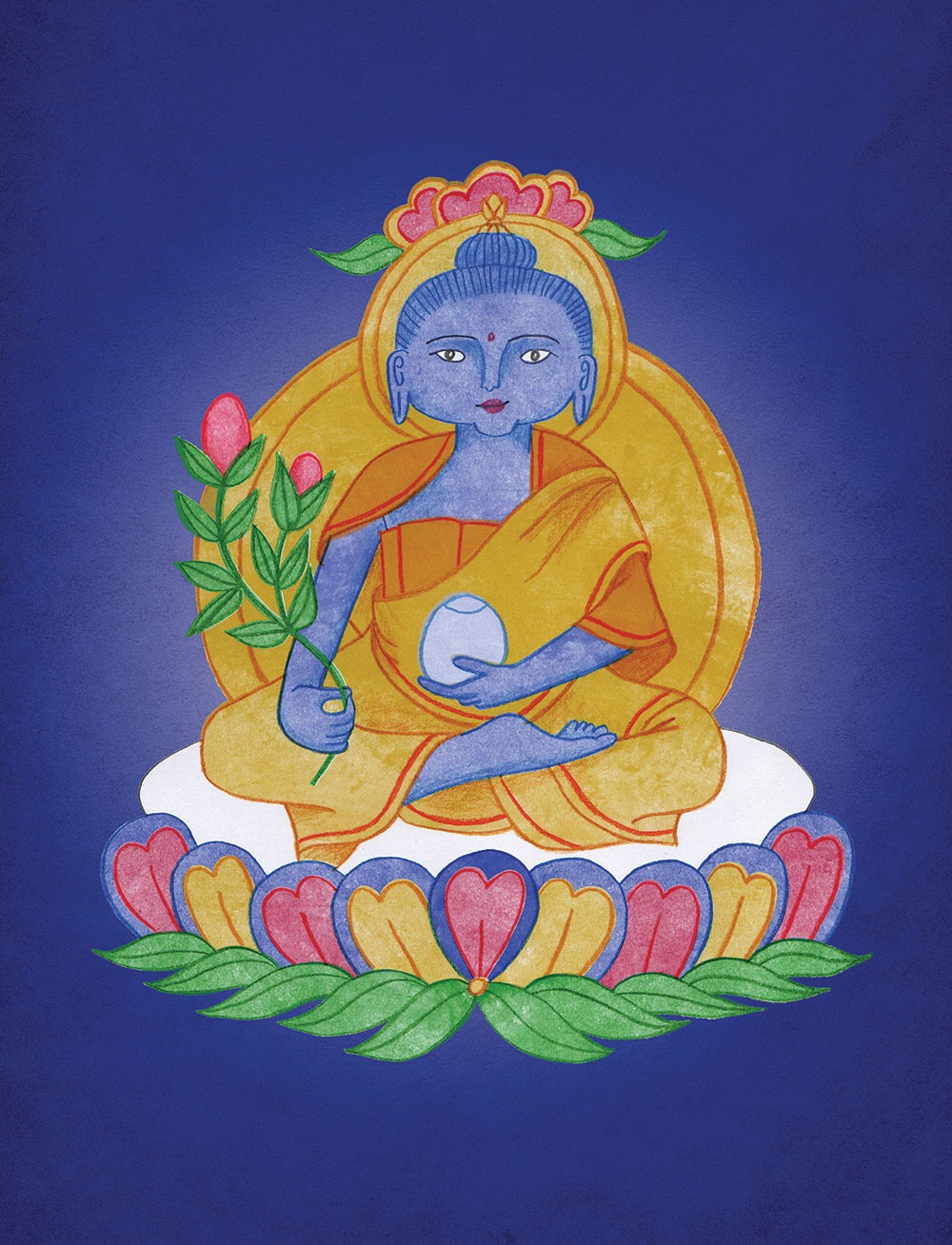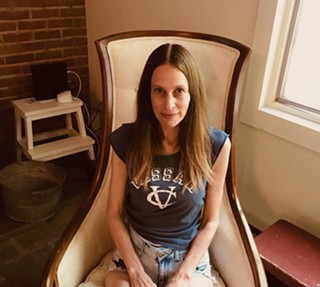Just over a year ago, Peter Buettner finally admitted to himself what a lot of people had been telling him: that something was not right. "I was walking funny, I had a tremor in my hand, my voice changed. I just wasn't my same self," says Buettner, 64, a Woodstock-area musician. A neurologist diagnosed him with early-stage Parkinson's disease, and he started a course of treatment doing everything by the book—taking Levodopa to alleviate his symptoms, showing up for regular appointments, eating well, exercising. Yet Buettner also did something that his doctors wouldn't have expected: He started a Medicine Buddha practice. Guided by lamas and teachers at the Karma Triyana Dharmachakra (KTD) monastery, he learned about the centuries-old traditions surrounding the lapis lazuli–colored "King of Medicine," as this particular Buddha is described in the Tibetan lineage of Vajrayana Buddhism. Immersing himself in meditation, visualization, and mantra, he invited the healing blue light of the Medicine Buddha to wash over his brain and body. To the uninitiated, it may sound naïve and unscientific, like so much spiritual hoodoo. But on a mental and emotional level the effects have been profound, as well as measurable and quantifiable.
"The main thing that it's done for me, the Buddhist practice, in whatever limited level I'm practicing on, is that it's changed my attitude toward the way I feel about having a chronic condition," says Buettner. "You make choices, things happen to you, and you're in environments that create conditions in your body that manifest as disease later. It's about being able to accept that and not take it personally. It's part of the karma of the human body." Despite the weight of his diagnosis, there's a peace and calm that emanates from Buettner which he can trace back to a practice that is not entirely new to him: He's been studying Buddhism, in a "hit or miss" sort of way, for the past 30 years. It's only since his Parkinson's diagnosis that he has stepped up his commitment and become very diligent. Daily visits to the monastery (possible now since he is on disability from his day job as a contractor) have allowed him to intensify his study and practice, and to meet more lamas and teachers who open new doors for him. Meditation is more accessible thanks to teachers such as Mingyur Rinpoche, who visited KTD in July. "He talked about developing awareness, being aware of your mental states," recalls Buettner. "It's not about trying to stop the mind or change the mind. Instead, whatever you can do to be aware in the moment and not be feeding your story, your neurosis—that's the practice in itself."
A Medical System with Spirit
Although Buettner is mainly employing the spiritual and mental aspects of practice, there is an entire world of traditional Tibetan medicine which combines the spiritual and the medical in one interconnected system of healing. Among other classical Asian systems, "Chinese and Ayurvedic medicine are much wider known [than Tibetan medicine]," says Eric Rosenbush, a teacher and acupuncturist who has studied in depth all three systems of healing, and who is leading a Tibetan Rejuvenation Immersion at Menla Center for Health and Happiness in Phoenicia this October 25–30. The weeklong retreat, co-taught with Buddhist teacher Robert Thurman, offers an introduction to the principles and practices of Tibetan medicine, which Rosenbush describes as "a blend of indigenous Tibetan healing techniques, some of which are shamanic and very old, with the Buddhist medical system of India that came over with Indian Buddhism starting over 1,400 years ago, as well as a strong influence of Chinese medical tradition and ancient Greek medical tradition. Tibetan medicine took all of these various influences and from around the 8th century really created its own system."
On a physical or subtle-body level, disease is understood in Tibetan medicine as an imbalance of the three principles: "rLung" (air or wind), "mKhris-pa" (fire), and "Bad kann" (earth and water). On the spiritual level, illness is described as resulting from three afflictions in Buddhist belief: ignorance, attachment, and aversion. Beyond these principles Tibetan medicine is a vast system that, according to Rosenbush, who is a student of the eminent Dr. Nida Chenagtsang, has strong clinical efficacy to treat disease. "The Tibetan doctors that are practicing throughout the world are for the most part very highly trained and skilled in their diagnostic techniques and use of different substances. [Tibetan medicine is] really a gem within medical systems in the world today."
With a home base in Himalayan India, not far from the Tibetan border, Rosenbush works for an NGO that helps local farmers and villagers preserve and cultivate high-elevation plants used in traditional healing. Many of these are the same unique, endemic plants that are sourced to create the herbal substances used in Tibetan medicine, along with Indian and Chinese herbs introduced through centuries-old trade networks. At Menla, Rosenbush has plans to cultivate local plants and flowers for traditional medicine-making in future Tibetan Rejuvenation programs, to be offered several times a year. During the retreat, participants engage in mild fasting, skipping at least one meal a day. "In place of a meal," says Rosenbush, "you learn to absorb vital energy from special herbal substances mixed with ghee or honey, or different kinds of herbal pills," many of which he creates. Called Chulen, or "extracting the essence," the practice is combined with breathing, visualization, meditation, and simple yoga to help cleanse and rejuvenate the body and mind. Participants also join in a Mendrub ceremony, which is a ritual with mandala-making and chanting to bless the medicine and "transmute it into nectar." Says Rosenbush, "It's quite profound, and it's another great example of how the Buddhist tradition and the medical tradition work together."
Compassion as Medicine
At KTD monastery, with its golden shrine room perched high above Woodstock, practices like these are woven into everyday life among the lamas, monks, teachers, and community of Buddhist practitioners. Above all, one Buddhist tenet emerges as a powerful vehicle for healing: compassion. A large part of Medicine Buddha practice involves compassion for the self and others; it aims to direct healing not just toward oneself, to ease one's own suffering, but also toward other beings who need healing and freedom from suffering. "We have three kinds of practices for healing and to protect from disease: the outer, the inner, and the innermost," says resident teacher Khenpo Karma Tenkyong. The outer practices are directed at protecting nature and other sentient beings, and often involve the live release of fish or other animals into their natural habitat. From there, the practice naturally moves inward, Khenpo explains. "Because you are a part of nature, you can feel your interdependence. Nature has the power of medicine: The inner person will come out. Then you're not going to eat something that's going to hurt you and cause disease. You love yourself and don't want to harm yourself, because you know how important is this human life. You will take care of your body, exercise, train your mind with meditation. When you train your mind and body, you are healing. Then you can turn to helping animals, to helping other people."
Khenpo knows that in the Western world of modern medicine, these basic views are far from orthodox. But for him, growing up in a remote village on the border of Nepal and Tibet, a simple approach to health was the only approach to health. "We had no doctor, no hospital, and until now we had no road. If someone had a wound we would use tree leaves, medicines. If there is a very serious problem we contact the government and pay them money to bring a helicopter. But most people do not have big disease; I never hear about cancer in our village." He chalks it up to Medicine Buddha practice—the "innermost" practice in Tibetan healing—taught to every child and practiced by every family in his village to this day.
Buettner, too, benefits from the simple heart qualities of these teachings on his journey with Parkinson's disease. "This really teaches you to use your condition, whatever condition or affliction that you have, as a springboard to compassion for other people and their suffering," he says. These days, he is unable to play the saxophone because his fingers can't hold certain keys down; he is, however, able to play the flute, compose music, and do basically all of his normal activities. "There are many people who are suffering far worse than I am," he adds. "Having to face my mortality, and the limitations that my condition is going to place on me as time goes by, inspires me to have compassion towards anyone who needs it, and to bring some kind of conscious energy to the healing of any suffering being."
Meet Your Inner Blue Healer
Rosenbush concurs that it all goes back to the Medicine Buddha—the "originator" of the Tibetan medical system and the source of all healing. "The Medicine Buddha is not necessarily a blue person or a blue alien that taught this medical tradition," he says lightly. "It is the enlightened essence of the perfectly realized potentiality of healing. Within everyone there is, we say, the Buddha nature. This is your own enlightened essence, the wisdom essence of your soul. In Tibetan medicine, the Medicine Buddha is really the heart, and can manifest in different ways as your highest potential for healing."
You don't have to be a Buddhist to manifest the Medicine Buddha's qualities; rather, the deity represents the potential in us all to heal and be healed. While the traditional way of Medicine Buddha practice involves a three-step process (including oral transmission from a teacher, an introduction to its meaning, and an initiation), anyone can practice by chanting the Medicine Buddha mantra: Tayata Om Bhekandze Bhekandze Maha Bhekandze Randza Samungate Soha (roughly translating as "Beyond All, Auspicious One, Medicine Buddha, Greatness of Medicine Buddha, Perfectly Awakened, Dissolve in Me"). Visualizations focus on healing blue light streaming from the Buddha's heart and body, and infusing the body of oneself or someone else who is suffering and needs healing. "No one will ever be able to prove that it works, but it couldn't hurt," says Buettner with a Buddha-like smile. "It's very comforting. And I really believe that by changing your mind, the quality of your thoughts and emotions, that changes your body chemistry. And that changes your experience."
By keeping his mind free of suffering, the experience of illness for Buettner need not be a prison sentence. On the contrary, he sees it as a gift—a special time to deepen his spiritual practice, and to keep making music. "Getting the diagnosis definitely puts a fire under your butt. You realize you better do what you love, make your life count, and do things with the benefit of all other sentient beings in mind, whatever you choose to do in life. Don't wait to live. There is no time to lose."
RESOURCES
Karma Triyana Dharmachakra Monastery Kagyu.org
Menla Center for Health and Happiness Menla.org.













